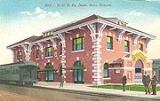
Nevada-California-Oregon Railroad Depot
Encyclopedia
The Nevada-California-Oregon Railroad Depot was built by the Nevada-California-Oregon Railway
in 1910 in Reno, Nevada
. It is Nevada Historical Marker
number 210. It is also listed in the National Register of Historic Places
.
The depot is a two-story rectangular brick building that has a variety of design styles. The low-pitch hip roof is clad in red Spanish tiles. The lower floor has Roman arches around the doors and windows. There is extensive use of concrete in this building, in the quoins, keystones, imposts, and sills.
The railroad was organized in Reno in June 1880 as the Nevada and Oregon Railroad
. It was decided that the best plan was to build north to the Columbia River to service cattle ranches and farms in northeastern California
and eastern Oregon
. The company decided to lay narrow-gauge track because it was cheaper than standard gauge
construction. It became one of the longest narrow-gauge railroads in the United States.
The railroad did well until the mid-1910s. In 1917, the railroad sold all of its holdings in the State of Nevada to the Western Pacific Railroad
(WP). The WP then replaced the narrow-gauge track with standard gauge. The depot continued to serve the citizens of Reno until 1937. In 1937 there was no longer passenger service, however the depot was used as offices by the WP until 1975. The building was then sold to private individuals who used it for a variety of functions..
The depot was listed in the National Register of Historic Places for its association with the Nevada-California-Oregon Railway, for the railroad development of Nevada, and for its distinctive architecture.
Nevada-California-Oregon Railway
The Nevada–California–Oregon Railway was a narrow gauge railroad originally planned to connect Reno, Nevada to the Columbia River. However, only of track were laid so service never extended beyond Lakeview, Oregon...
in 1910 in Reno, Nevada
Reno, Nevada
Reno is the county seat of Washoe County, Nevada, United States. The city has a population of about 220,500 and is the most populous Nevada city outside of the Las Vegas metropolitan area...
. It is Nevada Historical Marker
Nevada Historical Markers
Nevada Historical Markers identify significant places of interest in Nevada's history. The Historic Marker Program was initiated by the Nevada State Legislature in 1967 to bring the state's heritage to the public's attention with on-site markers...
number 210. It is also listed in the National Register of Historic Places
National Register of Historic Places
The National Register of Historic Places is the United States government's official list of districts, sites, buildings, structures, and objects deemed worthy of preservation...
.
The depot is a two-story rectangular brick building that has a variety of design styles. The low-pitch hip roof is clad in red Spanish tiles. The lower floor has Roman arches around the doors and windows. There is extensive use of concrete in this building, in the quoins, keystones, imposts, and sills.
The railroad was organized in Reno in June 1880 as the Nevada and Oregon Railroad
Nevada and Oregon Railroad
The Nevada and Oregon Railroad was an American narrow gauge railroad that operated from Reno, Nevada then northwest to the California state line near present day Hallelujah Junction. A portion of the route is part of today's Union Pacific Railroad branch connecting their Feather River mainline...
. It was decided that the best plan was to build north to the Columbia River to service cattle ranches and farms in northeastern California
California
California is a state located on the West Coast of the United States. It is by far the most populous U.S. state, and the third-largest by land area...
and eastern Oregon
Eastern Oregon
Eastern Oregon is the eastern part of the U.S. state of Oregon. It is not an officially recognized geographic entity, thus the boundaries of the region vary according to context. It is sometimes understood to include only the eight easternmost counties in the state; in other contexts, it includes...
. The company decided to lay narrow-gauge track because it was cheaper than standard gauge
Standard gauge
The standard gauge is a widely-used track gauge . Approximately 60% of the world's existing railway lines are built to this gauge...
construction. It became one of the longest narrow-gauge railroads in the United States.
The railroad did well until the mid-1910s. In 1917, the railroad sold all of its holdings in the State of Nevada to the Western Pacific Railroad
Western Pacific Railroad
The Western Pacific Railroad was a Class I railroad in the United States. It was formed in 1903 as an attempt to break the near-monopoly the Southern Pacific Railroad had on rail service into northern California...
(WP). The WP then replaced the narrow-gauge track with standard gauge. The depot continued to serve the citizens of Reno until 1937. In 1937 there was no longer passenger service, however the depot was used as offices by the WP until 1975. The building was then sold to private individuals who used it for a variety of functions..
The depot was listed in the National Register of Historic Places for its association with the Nevada-California-Oregon Railway, for the railroad development of Nevada, and for its distinctive architecture.

